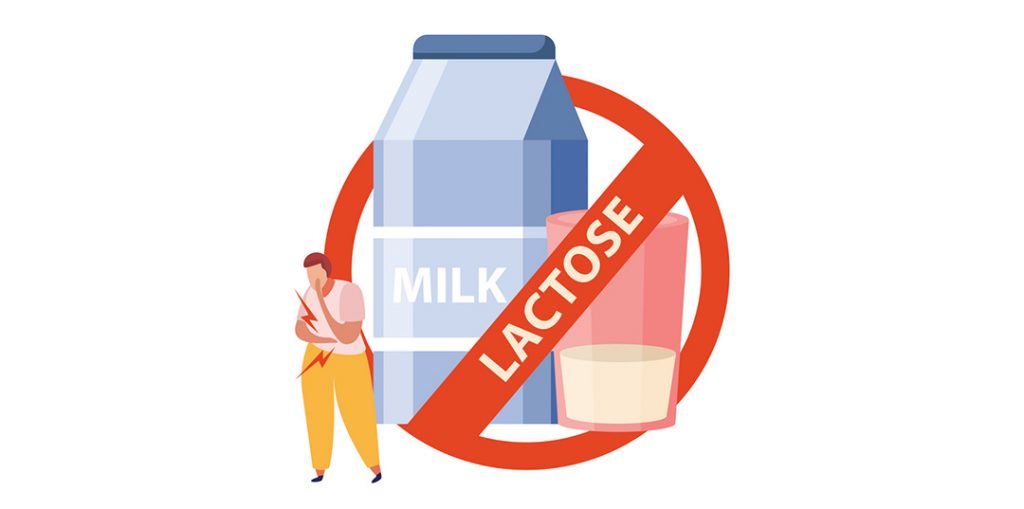Lactose Intolerance, How to find it out if you are so?

While consuming foods that contain lactose some may show different symptoms is termed lactose intolerance.
It is very common and affects almost 70% of people around the world.
Lactose
The milk of mammals like cows, goats, and humans naturally contain a milk sugar called Lactose.
Not all milk products contain the same amount of lactose; for example, cheddar, parmesan, or Swiss cheese contain very little lactose, but milk, ice cream, and yogurt contain large amounts of lactose.
Digestion of lactose takes place in the small intestine with the assistance of the digestive enzyme called lactase. It breaks down lactose into glucose and galactose and makes them available for absorption.
Lactase production is excessive during infancy, however, lactase production quickly and drastically slows and typically diminishes as we age.
This decrease in lactase production results in the inability to digest lactose later.

Lactose Intolerance
It is when an ice cream treat or a glass of milk leaves a person complaining of an upset stomach or even puking.
When your body does not produced enough lactase you are lactose intolerant.
This results in physical symptoms like abdominal bloating, cramps, diarrhea, and gas.
The microbiota present in the gut ferments undigested Lactose while passing through intestine.
This builds carbon dioxide and hydrogen and other certain byproducts that stimulates bowel movements.
The symptoms observed, and how sensitive a person is to the effects of malabsorption, further the amount of lactose in the diet matters.
Various laboratory tests along with evaluating symptomatic response to ingestion of lactose-containing products detect lactose intolerance.
The mainstay of treating it primarily comes out with less consumption of milk and its products.
Adding lactase supplementation either in the form of pills or solution to milk or its consumption before the intake of dairy lower the symptoms.

How to find it out if you are so?
The National Institutes of Health are under an impression that approximately two-thirds of people do not fully digest lactose beyond their childhood.
Lactose intolerance develops in three different ways. They are the following:
- Primary lactose intolerance
This is a common type that is the result of ageing. People are often born with enough lactase that is required. However, the amount of lactase produced may gradually decrease over time as people age.
This is more common among the people of Asian, African, and Spanish-speaking countries, especially those of Latin American ancestry.
- Secondary lactose intolerance
This type occurs as an aftereffect of some illness or injuries.
Intestinal diseases, surgery, or an injury to the small intestine could be a cause. Later the level of lactase can be restored if the underlying disorder is managed.
The tenure of secondary lactose intolerance prevails depending on the causative factor in individuals.
- Congenital or developmental lactose intolerance
This is a condition of being born with lactose intolerance which is inherited from the parents by birth. A defective gene is transmitted from parents that result in a complete absence of lactase in the child.
This could be easily treated by providing a lactose-free infant formula instead of milk.
Developmental lactose intolerance develops when a baby is born prematurely, as lactase production in babies begins later in the pregnancy, after at least 34 weeks.
Since the symptoms are general, an accurate diagnosis before removing dairy from the diet is necessary.
Usually, the majority of people with extreme of this condition experience symptoms like an urgent need to go to the toilet, vomiting, lower belly pain, and constipation.
However, in some case people also show symptoms like skin complaints or headaches; the severity of symptoms vary on how much lactose one can tolerate.
And those who show no symptoms may seem tolerant but the conditions of intolerance could prevail in them and may expose them at some point in time.
Are you lactose intolerant?
In some studies, carried out in people who are prone to this were found to carry certain genes which brought in the knowledge that the presence of those genes may cause chances of being lactose intolerant.
Therefore knowing your genes through genetic tests beforehand would enable you to check preventive measures. EPLIMO is one such test through which you can see whether you are lactose tolerant or not.

Are you lactose intolerant? You can relax!
Are you an ardent coffee lover? But are you worried about your lactose intolerance nature preventing you from enjoying an aromatic cup of brew?
Times up for you to stop worrying!!!
The delicious lactose-free VIECAFE from the house of Vieroots is for you which contains premium quality non-dairy ingredients.
Enjoy your cup of coffee stress-free…





I had a problem with milk products whenever I take after few hours it’s gastric problems comes.
So last year I take my Eplimo & just got information that I’m highly lactose intolerance with the reason of this vitiligo comes in my body. I just stop & it’s awesome results comes in my body.
Thank you Vieroots
Whenever you feed your genes. Actually then afterwards your life shines. The most powerful and effective lifestyle modification is Eplimo. One Decision, Once In A Lifetime Program.